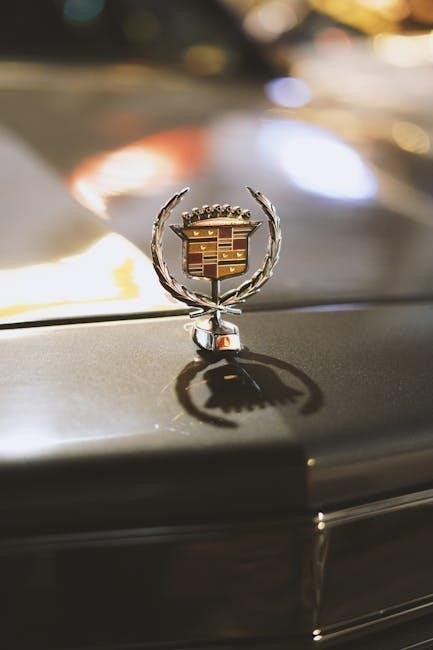Brownie Design with Nature Badge: Requirements and Activities
The Brownie Design with Nature badge introduces mathematical concepts within the natural world. Brownies explore age calculation of natural objects‚ beehive shapes‚ and bird feeder construction. This badge‚ part of the Math in Nature series‚ encourages hands-on activities and outdoor exploration. It combines learning about nature with practical math skills.
Overview of the Design with Nature Badge
The Design with Nature badge is a fantastic opportunity for Brownie Girl Scouts to explore the intersection of mathematics and the natural world. This badge‚ part of the Math in Nature series‚ encourages young girls to see how math is not just something learned in the classroom‚ but a tool that can be used to understand and interact with the environment around them.
Through a series of engaging activities‚ Brownies will discover the wonders of nature while simultaneously developing their math skills. They will learn to apply mathematical concepts like measurement‚ scale‚ ratios‚ and graphing to real-world scenarios found in nature. This hands-on approach makes learning fun and relevant‚ fostering a deeper appreciation for both math and the environment.
The badge focuses on practical applications‚ such as calculating the age of natural objects‚ exploring the shapes of beehives‚ and building a bird feeder. By completing these activities‚ Brownies will not only earn a badge but also gain valuable skills and knowledge that they can use throughout their lives. This badge provides a unique and enriching experience for Brownies‚ promoting STEM learning in an accessible and exciting way.
Badge Requirements Breakdown
The Brownie Design with Nature badge is structured around five core requirements‚ each designed to engage Brownies in mathematical exploration within a natural context. The first requirement involves calculating the age of a natural object‚ encouraging girls to research and apply methods for determining the age of trees or other natural elements. This fosters an understanding of time scales in nature.
The second requirement focuses on exploring the shapes of beehives‚ prompting Brownies to investigate the geometry and efficiency of honeycomb structures. This introduces concepts like tessellations and hexagonal patterns. The third requirement involves measuring and building a bird feeder‚ requiring girls to apply measurement skills and follow instructions to create a functional object that benefits local wildlife.
The fourth and fifth requirements delve further into mathematical applications. One option involves using scale and ratios in nature‚ where Brownies might create a scaled-down model of a natural habitat or compare the sizes of different organisms. The final requirement asks them to make a graph related to nature‚ which could involve tracking bird sightings‚ plant growth‚ or weather patterns. These requirements collectively provide a well-rounded introduction to math in nature.
Calculating the Age of Natural Objects
One of the key requirements for earning the Brownie Design with Nature badge is learning how to calculate the age of natural objects. This activity encourages Brownies to explore the concept of time and how it relates to the natural world around them. A common method is to determine the age of a tree by counting its growth rings. Each ring represents one year of the tree’s life‚ providing a visual record of its growth and the environmental conditions it experienced.
Brownies can also explore other methods for estimating the age of natural objects. For example‚ they could research how geologists determine the age of rocks or how scientists estimate the age of fossils. They might also investigate how the age of a shell can be estimated by examining its layers. This requirement not only teaches mathematical skills but also fosters an appreciation for the history and longevity of natural elements.
To fulfill this requirement‚ Brownies can document their findings and share them with their troop‚ explaining the methods they used and the ages they calculated. This promotes communication and collaboration while reinforcing their understanding of the topic.
Exploring the Shape of Beehives
The Brownie Design with Nature badge includes an engaging requirement that involves exploring the shape of beehives. This activity introduces Brownies to the fascinating world of bees and the mathematical principles behind their honeycomb structures. Beehives are composed of hexagonal cells‚ which are a marvel of natural engineering.
The hexagonal shape is not arbitrary; it’s the most efficient way to store honey using the least amount of wax. Brownies can learn about tessellations‚ which are patterns formed by repeating shapes that fit together without gaps or overlaps. The hexagonal cells in a honeycomb are a perfect example of a tessellating shape. By examining honeycomb structures‚ either in real life (under safe supervision) or through pictures and videos‚ Brownies can understand the efficiency and beauty of this natural design.
They can also create their own tessellations using hexagonal tiles or drawing them on paper. This hands-on activity reinforces their understanding of geometry and the mathematical principles underlying the natural world. Exploring the shape of beehives provides a unique and educational way for Brownies to connect math and nature.
Measuring and Building a Bird Feeder
One of the key requirements for earning the Brownie Design with Nature badge involves measuring and building a bird feeder. This hands-on activity allows Brownies to apply their math skills in a practical and engaging way while also contributing to their local ecosystem. Building a bird feeder requires careful measurement of materials‚ understanding spatial relationships‚ and following instructions.
Brownies will need to measure wood‚ plastic‚ or other materials to create the bird feeder’s structure. They can use rulers‚ measuring tapes‚ or other measuring tools to ensure accurate dimensions. This process reinforces their understanding of units of measurement‚ such as inches‚ feet‚ or centimeters; They will also learn about shapes and angles as they construct the different parts of the bird feeder.

Furthermore‚ building a bird feeder encourages problem-solving skills. Brownies may encounter challenges during the construction process‚ such as pieces not fitting together correctly. They will need to troubleshoot and find solutions‚ which promotes critical thinking and perseverance. Once the bird feeder is complete‚ Brownies can observe the birds that visit it‚ learning about different species and their feeding habits. This activity combines math‚ construction‚ and nature observation in a fun and educational way.
Using Scale and Ratios in Nature
The Brownie Design with Nature badge includes an activity focused on understanding scale and ratios in the natural world. This requirement encourages Brownies to explore how proportions and comparisons are present in various aspects of nature‚ fostering a deeper appreciation for mathematical concepts. By examining real-world examples‚ Brownies learn to apply scale and ratios in a meaningful context.

One way to explore scale and ratios is by comparing the sizes of different animals or plants. For instance‚ Brownies could compare the length of an ant to the height of a tree‚ expressing this relationship as a ratio. They can also examine maps and learn how distances on the map relate to actual distances on the ground. This activity introduces the concept of map scales and helps Brownies understand how to interpret spatial information.
Another engaging activity involves creating scaled drawings of natural objects. Brownies can choose a leaf‚ a flower‚ or a small insect and draw it to a larger or smaller scale‚ maintaining the correct proportions. This exercise reinforces their understanding of ratios and proportions while also enhancing their artistic skills. By exploring scale and ratios in nature‚ Brownies develop a valuable mathematical skill and a greater awareness of the world around them.
Making a Graph Related to Nature
As part of earning the Brownie Design with Nature badge‚ Brownies are required to create a graph related to nature. This activity introduces them to data collection‚ organization‚ and visual representation‚ fostering essential STEM skills. By engaging with graphs‚ Brownies learn to interpret information‚ identify trends‚ and draw conclusions based on evidence‚ all within the context of the natural world.
One engaging way to fulfill this requirement is by conducting a nature survey. Brownies can choose a local park‚ garden‚ or even their own backyard and count different types of plants‚ insects‚ or birds. They can then use this data to create a bar graph showing the number of each species observed. This activity not only teaches graphing skills but also encourages observation and appreciation for biodiversity.
Another option is to track weather patterns over a period of time. Brownies can record daily temperatures‚ rainfall amounts‚ or hours of sunlight and then create a line graph to visualize these trends. This exercise helps them understand how data can be used to analyze environmental changes. Through creating and interpreting nature-related graphs‚ Brownies develop valuable skills in data analysis and scientific inquiry.
Activity Ideas for Earning the Badge

Earning the Brownie Design with Nature badge involves engaging in hands-on activities that connect math concepts to the natural world. To fulfill the requirement of calculating the age of a natural object‚ Brownies can examine tree rings or research the lifespan of various plants and animals. This activity promotes observation skills and an understanding of time scales in nature.
Exploring the shape of beehives can be done through observation or research. Brownies can learn about the hexagonal structure of honeycombs and how this shape maximizes space efficiency. Activities could include building a honeycomb model or creating tessellations inspired by beehive patterns.
Measuring and building a bird feeder offers a practical application of math skills. Brownies can use rulers and measuring cups to determine the dimensions of the feeder and the amount of birdseed needed. This activity encourages teamwork‚ problem-solving‚ and an appreciation for wildlife.
To understand scale and ratios‚ Brownies can create miniature gardens or maps. This allows them to apply proportional reasoning and spatial awareness. Finally‚ making a graph related to nature can involve tracking weather patterns‚ counting different types of plants‚ or recording animal sightings. These activities foster data collection‚ analysis‚ and presentation skills.
Resources for Leaders and Brownies
To support leaders in guiding Brownies through the Design with Nature badge‚ several resources are available. The official Brownie Girl Scout Handbook provides detailed badge requirements and activity suggestions. Volunteer guides offer additional tips and insights for facilitating each step of the badge. Online platforms‚ such as the Girl Scouts website‚ offer activity ideas and printable resources.
Field guides on local flora and fauna can help Brownies identify natural objects and learn about their characteristics. These guides are useful for completing the age calculation requirement and for exploring the shapes found in nature. Access to outdoor spaces‚ such as parks‚ nature trails‚ or even backyards‚ is essential for hands-on activities and observations. Materials for building a bird feeder‚ such as wood‚ nails‚ and birdseed‚ should be readily available.

For the graphing activity‚ provide graph paper‚ pencils‚ and data collection sheets. Encourage Brownies to use these resources to record their findings accurately. Leaders can also connect with local nature centers or environmental organizations for expert advice and potential field trip opportunities. Utilizing these resources ensures a successful and enriching experience for both leaders and Brownies as they explore math in nature.
